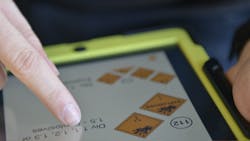The First Responder Network Authority (FirstNet), an independent authority within the U.S. Department of Commerce, was created to equip America’s first responders with state of-the-art communications tools, including a nationwide interoperable, wireless network. The Middle Class Tax Relief and Job Creation Act of 2012 requires FirstNet to take all actions necessary to ensure the building, deployment and operation of the first high-speed, nationwide public safety broadband network (NPSBN) in all 50 states, the five U.S. territories, and the District of Columbia. The creation of this law and FirstNet, and the ultimate establishment of a dedicated public safety network, can be credited to first responders who made their voices heard, pushing for action on the 9/11 Commission recommendation calling for interoperable communications for all U.S. first responders.
I joined FirstNet in November 2015, leaving the Phoenix Fire Department where I had served for 29 years, to be a part of this monumental effort to put lifesaving technology in responders’ hands. Reliable broadband connectivity is a valuable, scarce resource, one that can open up doors to tremendous public safety communications capabilities. First responders deserve the best, and FirstNet is working to establish the best Long Term Evolution (LTE) network it can, one that evolves as technology evolves.
When I left Phoenix, I was the Division Chief of Technical Services, and I observed an increase in requests for access to mobile data and applications for field use. There was minimal official use of mobile data at the handheld level. Many of the field personnel were (and still are) using their personal devices to get access to applications for daily use and for use on incidents. There is a huge demand for mobile data services, and firefighters are filling this data gap with the use of personal devices. The personal devices they use rely upon commercial LTE networks to provide data to the devices. Many in the fire service may ask “Why do we need this LTE technology?” but if you have a computer-aided dispatch (CAD) terminal or computer in the fire apparatus, you are probably using it today.
Game-changing technology
With each generation of LTE—now in its fourth generation (4G)—comes improvement in speed and functionality. FirstNet is involved in the international standards process and works closely with public safety to develop standards and functionalities that meet the needs of the first responders. FirstNet’s participation in the international standards bodies places technical specifications into the standard to meet the operational needs of firefighters. Use of global standards will be a factor in the cost of the devices that will eventually be in firefighters’ hands. FirstNet is one of several international projects to provide this capability to public safety. South Korea, the United Kingdom and Canada are among those countries that have similar initiatives in progress.
While LTE is tried and tested in the consumer market, FirstNet is going to differ from commercial networks in many ways, including the provision of reliability required by firefighters. When commercial systems are used, public safety is in direct competition with the public to get access to data bandwidth. If public safety does get access, the speeds may be so slow that public safety applications don’t run. To ensure that the FirstNet network is accessible and useable by first responders, the system will use “mission critical” features to maintain utility in all situations.
There are several documented cases where data access was not available to first responders. In the 2013 Boston Marathon bombing, the large concentration of people all trying to communicate simultaneously caused congestion in the commercial systems. Another instance was the 2011 magnitude 5.8 earthquake in Virginia. While there were no “system malfunctions,” there were service disruptions in New York and Washington, D.C.
The commercial providers recently started offering priority in their systems. While this is a welcome change in their offerings, it does not fully meet the needs of public safety. If the commercial system is congested to the point of saturation, the fire service may not be able to access the system, even if it has priority. In other words, you must have access to get priority. If you do get access to the commercial system, the bandwidth and speeds may not be adequate. FirstNet will employ Quality of Service, Priority and Pre-emption (QPP) to ensure access, quality and speed. This is an important point because FirstNet was allocated a separate frequency band (Band 14) that operates under different FCC rules than the commercial bands. The rules the commercial providers operate under do not allow pre-emption. Another difference is that FirstNet devices will operate at higher power levels than the commercial devices available today. This is an important tool for engineers to provide coverage in challenging areas.
FirstNet is not being built with the same intent as a commercial system. The system buildout is mandated by law to meet rural buildout milestones. Commercial providers’ buildouts are based on profitability of placing sites based on the number of system subscribers. They do not build in areas where there are not enough subscribers to justify a large monetary investment. FirstNet is being built to provide coverage to all public safety, both urban and rural. This will not happen instantaneously, and it depends on the buildout strategy, but the buildout will be a balanced rural-urban approach. The cost to procure and access the data system is always an issue. It must be affordable and competitive with the commercial providers because there is no mandate for public safety entities to use the FirstNet network. By the law, FirstNet must be self-sustaining. This requires FirstNet to provide a service that is so good that there will be a reason to shift from commercial service to the FirstNet network. FirstNet continues to take measures to ensure that the system is both affordable and compelling for public safety entities.
FirstNet, with public safety input, recognizes the requirement for sites that can survive severe weather, and geologic and manmade events. These include hurricanes, floods, tornadoes, earthquakes, wildland fires, terrorist attacks and others. Each state and territory is advising FirstNet on the hazards and events associated with its area. The input received assists in defining Public Safety Grade (PSG) hardening needed for survivability of the infrastructure during and after these events. Some of these requirements include wind load on the towers, generator/battery power and the hardening of the structure itself. The combination of QPP, coverage and PSG means that the system will provide access and performance where we need it when we need it most.
Relentless innovation
There are many misconceptions about FirstNet and Land Mobile Radio (LMR). LMR systems need to be maintained into the foreseeable future. FirstNet is working with the international standards bodies to include technical specifications to implement mission-critical voice (MCV), but this will not be offered during the initial deployment. As we continue to develop standards for mission-critical voice over LTE, firefighters and other public safety personnel will continue to rely on LMR networks for MCV communications. For MCV to be implemented, there are some obstacles that must be overcome. One of these is off-network capability. This is similar to operating on a trunked radio system and going out of range and having to switch to a simplex or direct channel. The direct channel is the off network channel in the trunked system. Adoption of MCV will also depend on the ability to provide in-building coverage. When MCV is offered, fire departments will have to conduct tests to see if MCV meets their operational requirements. The network is also expected to provide non-mission-critical voice at launch. This may provide some relief to agencies that do not have enough radio spectrum for support functions. Public safety entities will need to maintain and/or upgrade their LMR networks, as appropriate.
When FirstNet launches, the network will provide mission‐critical, high‐speed data and video services, such as location information and streaming video, which will augment today’s LMR networks. Another service that is being developed is Location Based Services (LBS) on the FirstNet network. We are all familiar with commercial location services. The services available today are useful but the accuracy of the current system is dependent on GPS. When firefighters enter buildings, we continue to need LBS to determine firefighter locations. This is especially true when we have maydays or other emergencies where information is needed immediately to affect rescue or mitigate a hazard. FirstNet is working with Public Safety Communications Research (PSCR) to develop new capabilities in LBS to maintain accuracy in-building and increase the accuracy specifications so that they meet public safety requirements. It is important to point out that FirstNet works very closely with PSCR in developing these new capabilities. The PSCR has approximately $300 million to invest in research and development of new technologies for responders. This is a significant investment to the safety of all public safety responders, and we should see significant advances in the near future.
The network being built by FirstNet will be a catalyst for innovation. There are many talented people in the fire service who are developing applications for the fire service on the commercial networks. Browsing through the app stores today, you can find many applications that are available for public safety. When FirstNet is launched, many of these app developers will likely shift their focus to FirstNet. When the app stores opened on the commercial side, initial app offerings were less than 1,000, and today, those app stores have close to 2 million apps. Development of applications that use the FirstNet network will eventually change the way firefighters do business on the streets, making them more accurate in their decisions, more efficient and safer so they go home after every shift.
Progress toward development
FirstNet’s job is to establish a network that offers incredible value to users. If we provide a compelling network that does what it should, we believe public safety users will adopt the FirstNet network and come to rely upon the network for their mission critical needs.
FirstNet continues to take many important steps forward in our efforts to deploy the FirstNet network and put life-saving technology into the hands of first responders. On Jan. 13, FirstNet issued its Request for Proposals (RFP) for the deployment of the network, marking a major step forward in FirstNet's efforts to modernize communications for first responders and other public safety personnel across the United States. The release of the RFP follows more than a year of dialogue with public safety and industry on the objectives and scope of the RFP for the FirstNet network. Through the RFP, FirstNet seeks to partner with a private sector entity to establish a mutually beneficial public-private partnership.
As we look ahead to 2016 and beyond, I am excited about our path forward to deploy a broadband network that will serve America's firefighters, EMS providers and other public safety personnel. I encourage the fire service to become active in the process—if you haven't done so already—by participating in FirstNet-related initiatives in your state or territory. For more information, visit FirstNet.gov.
About the Author

Mike Worrell
Mike Worrell is the FirstNet Senior Fire Services Advisor. He was previously with the Phoenix Fire Department where he served for 29 years, most recently as the technical services division chief. Worrell was also a member of the Public Safety Advisory Committee (PSAC) to FirstNet, a member of the National Urban Search and Rescue Incident Support Team, and a qualified Communications Unit Leader and Communications Technician instructor. Prior to joining the Phoenix Fire Department, he was an electronics technician in the U.S. Navy, Submarine Service.
